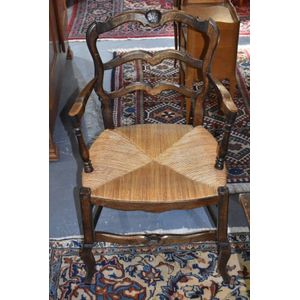French Oak Ladderback Armchairs, Louis XV Style
You must be a subscriber, and be logged in to view price and dealer details.
Subscribe Now to view actual auction price for this item
When you subscribe, you have the option of setting the currency in which to display prices to $Au, $US, $NZ or Stg.
- Rush Seating - Associated with country style chairs, stools and settees, rush seats are woven from rushes, with the pattern of the weaving often dividing the the chair seat diagonally into four triangles.
The weaving of rushes has been practiced for centuries, and it is believed that some early rush seats of the 18th and 19th century were painted, although common practice now is to leave the rush in its natural state. As the rush ages the colour
Rushes of the type used in Europe for seating are not available in Australia, and instead fibre rush, a man-made product from one-ply twisted paper, is used. Another substitute material is twisted natural sea grass.
Seats in Danish furniture of the 1950s were often finished with Danish cord, a three ply twisted paper cord, which has a similar appearance to rush. - Oak - Native to Europe and England, oak has been used for joinery, furniture and building since the beginning of the medieval civilisation. It is a pale yellow in colour when freshly cut and darkens with age to a mid brown colour.
Oak as a furniture timber was superceded by walnut in the 17th century, and in the 18th century by mahogany,
Semi-fossilised bog oak is black in colour, and is found in peat bogs where the trees have fallen and been preserved from decay by the bog. It is used for jewellery and small carved trinkets.
Pollard oak is taken from an oak that has been regularly pollarded, that is the upper branches have been removed at the top of the trunk, result that new branches would appear, and over time the top would become ball-like. . When harvested and sawn, the timber displays a continuous surface of knotty circles. The timber was scarce and expensive and was used in more expensive pieces of furniture in the Regency and Victorian periods.
This item has been included into following indexes:
-
chairs, singles / pairs / threes, style or period
- armchairs 1,732
- country style 91
- French 949
- ladderback 61
- Louis XV 353
- rush-seated 115
- chairs, singles / pairs / threes, timber - oak 488
Visually similar items

Antique Georgian armchair circa 1800, approx 93 cm high, 56 cm wide

Chinese yellow hardwood chair. Carved medallion to splat back. Height 104 cm

A Germanic cedar kitchen chair

A mahogany Regency revival occasional chair, mid 20th century, the carver with a shaped square back and three slender pierced splats, sweeping arm rests to reeded supports, a stuffover seat and raised on slender reeded legs to small toupie feet; upholstere
